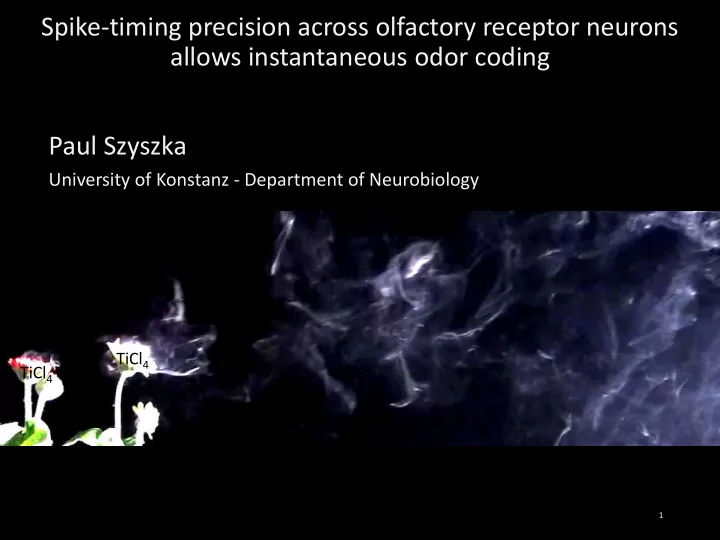

Spike-timing precision across olfactory receptor neurons allows instantaneous odor coding Paul Szyszka University of Konstanz - Department of Neurobiology TiCl 4 TiCl 4 1
Temporal precision Odor source separation of receptor neurons Celani, Villermaux, Vergassola (2014) Odor Landscapes in Turbulent Environments Phys Rev 2
3 Celani et al., 2014 Phys Rev
Olfactory cocktail party Celani et al., 2014 Phys Rev
Sound source separation based on onset asynchrony 0 500 0 500 (ms) Lipp et al. (2010) Neuropsychologia Celani et al., 2014 Phys Rev
Frasnelli et al., 2010 6 Celani et al., 2014 Phys Rev
Bees use onset asynchrony for odor separation Training Test A -6 ms- B AB B -6 ms- A Odor A (800 ms) + sugar Response to odor (% bees) ns R. Menzel N=142 bees Szyszka, Stierle, Biergans, Galizia (2012) PLoS ONE
Odor source separation based on spatial / temporal structure Hopfield & Gelperin Tim Holy & (1989) Behav Neurosci Ningdong Kang Baker & Fadamiro (1998) Nature Andersson, .. Schlyter (2011) J Chem Ecol Andreas Schäfer Weissburg, .. Mankin x (2012) J Exp Biol Szyszka, .. Galizia (2012) PloS one
Temporal precision Odor source separation of receptor neurons Celani, Villermaux, Vergassola (2014) Odor Landscapes in Turbulent Environments Phys Rev 10
11
Speed of odor processing is not compatible with rate coding Odorant ORN X ORN Y 12
Rate code Odorant ORN X ORN Y 1/rate 13
Synchrony code Odorant ORN X ORN Y Jitter 14
First spike latency code Odorant ORN X ORN Y Jitter 15
Spike timing precision constrains coding speed Odorant ORN X ORN Y 1/rate Jitter Jitter 16
Odorant at sensillum Diffusion Receptor binding Michael Laumann Channel opening 500 nm Ion flow Olfactory receptor neurons Spike 17 A. Renner
Paired recordings from olfactory receptor neurons rise time: 3.61 ±0.03 ms Methyl butyrate Drosophila v v antenna 18 Egea-Weiss, Renner, Kleineidam, Szyszka (unpublished)
ab2A neurons Methyl butyrate 19 Egea-Weiss, Renner, Kleineidam, Szyszka (unpublished)
Spike latency varies over a wider concentration range than rate Latency [ms] Jitter [ms SD] 1/rate [ms] Min. inter-spike interval [ms] First spike latency [ms] Methyl butyrate; n= 14 ab2A neurons 20
Spike latency varies over a wider concentration range than rate Latency [ms] Jitter [ms SD] 1/rate [ms] Min. inter-spike interval [ms] First spike latency [ms] Methyl butyrate; n= 14 ab2A neurons 21
What signal do the postsynaptic neurons receive? 23 ab2A Receptor neurons Grabe, Baschwitz, Dweck, Lavista-Llanos, (Or59b) Hansson & Sachse (2016) Cell Reports Kazama & Wilson (2009) Nature Neurosci 1 Projection neuron Glomerulus DM4 22
Convergences allows rapid stimulus detection 2 23
Latency [ms] Jitter [ms SD] 1/rate [ms] Stimulus detection [ms] Min. inter-spike interval [ms] First spike latency [ms] Methyl butyrate; n= 14 ab2A neurons 24
The sequence of first spike latencies across receptor neurons encodes odorant identity (and is concentration invariant) First spike latency Min. inter-spike interval (1/rate) -6 Air ab3A [ms] ab3A [ms] -2 Ethyl acetate Methyl butyrate ab2A [ms] ab2A [ms] Median, 5 th -95 th percentile range, 10 - 14 neurons per odorant/neuron Egea-Weiss, Renner, Kleineidam, Szyszka (unpublished) 25
Fast odor transduction occurs across insect species Honey Fruit fly Locust Dubia Hissing Hawk bee roach roach moth A. Hinterwirth www.entomos.ch 1.9 Latency (ms): 2.2 1.6 2.0 3.0 4.6 125 Pulse following (Hz): 125 125 50 83 100 Egea-Weiss, Renner, Kleineidam, Szyszka (unpublished) 26 Szyszka, Gerkin, Galizia, Smith (2014) PNAS
Summary & Conclusion Odorant A Odorant A, B ab2A ab2A ab3A ab3A First spike latency: < 3 ms Jitter: < 0.3 ms (stimulus detection: < 0.02 ms) - Synchrony across receptor neurons encodes odor stimulus onset. - Latency and jitter of first spike latencies encodes odorant concentration. - The order of first spike latencies across receptor neurons encodes odorant identity (and is concentration invariant). - The olfactory system could use temporal encoding for fluctuating odor stimuli, and rate encoding for static odor stimuli. - First spike latency coding supports odor source separation. 27
Acknowledgments Alpha Renner Alex Egea-Weiss Georg Raiser Christoph Kleineidam Giovanni Galizia Thomas Nowotny Brian Smith Ryohei Kanzaki University of Sussex Arizona State University University of Tokyo Odor-Background Segregation
Recommend
More recommend